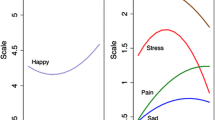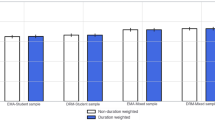Abstract
Part of a wider range of investigations to produce generally acceptable standards for measuring affective well-being, time diary surveys have tested several approaches to measuring subjective well-being during diary days. As an alternative to the standard approach of asking a single question about each activity reported in time diary surveys, the 2010 module of the American Time Use Survey asked six emotion questions about three activities. The perception questions captured how happy, meaningful, sad, tired, stressed, or in pain respondents felt on a 7-point scale. To evaluate this approach, our research examined the reliability and validity of the six emotion questions, and assessed their variability across activities. Using principal component analysis, we assessed the associations among items and obtained two activity-level components with Cronbach’s alphas of 0.68 and 0.59 and two respondent-level components with Cronbach’s alphas of 0.74 and 0.65. To test validity, we regressed self-rated health on the underlying components and socio-demographic controls. Both of the respondent level components were significantly associated with better health (odds ratio 1.81, 1.27). Using each of the perceptions individually, we found that happiness, meaningfulness, and lack of fatigue, stress, and pain were related to better health, but none as strongly as the first component. Finally, we examined the coefficients of variation to assess the variability in the well-being measures across activities. Measurement implications and limitations of this study are discussed.


Similar content being viewed by others
Notes
The BLS reported a problem with the selection of activities other than sleeping in the last episode for the 2010 and 2012 ATUS module and re-released corrected weights on May 21, 2014. This study used the 2010 well-being module data containing the weights adjusted for this error. For more information see http://www.bls.gov/tus/wbnotice.htm; accessed July 9, 2014.
References
Abraham, K., Maitland, A., & Bianchi, S. (2006). Nonresponse in the American Time Use Survey: Who is missing from the data and how much does it matter? Public Opinion Quarterly, 70(5), 676–703. doi:10.1093/poq/nfl037.
Bureau of Labor Statistics. (2014). American Time Use Survey. http://www.bls.gov/tus/. Accessed 9 July 2014.
Csikszentmihalyi, M., & Hunter, J. (2003). Happiness in everyday life: The uses of experience sampling. Journal of Happiness Studies, 4(2), 185–199.
Csikszentmihalyi, M., & Larson, R. (1987). Validity and reliability of the experience-sampling method. Journal of Nervous and Mental Disease, 175(9), 526–536.
de Mello, L., & Tiongson, E. (2009). What is the value of (my and my family’s) good health? Kyklos, 62(4), 594–610. doi:10.1111/j.1467-6435.2009.00453.x.
Diener, E., & Tay, L. (2014). Review of the day reconstruction method (DRM). Social Indicators Research, 116(1), 255–267. doi:10.1007/s11205-013-0279-x.
Drobnic, S., & Guillén, A. M. (Eds.). (2011). Work-life balance in Europe: The role of job quality. Basingstoke, UK: Palgrave Macmillan.
Freedman, V., Conrad, F., Cornman, J., Schwarz, N., & Stafford, F. (2014). Dose time fly when you are having fun? A day reconstruction method analysis. Journal of Happiness Studies, 15(3), 639–655. doi:10.1007/s10902-013-9440-0.
Gershuny, J. (2013). National utility: Measuring the enjoyment of activities. European Sociological Review, 29(5), 996–1009. doi:10.1093/esr/jcs077.
Haas, S. (2007). The long-term effects of poor childhood health: An assessment and application of retrospective reports. Demography, 44(1), 113–135.
Hektner, J., Schmid, J., & Csikszentmihalyi, M. (2007). The Experience sampling method. Thousand Oaks: Sage Publications.
Hofferth, S., Flood, S. & Sobek, M. (2013). American Time Use Survey Data Extract System: Version 2.4. [Machine-readable database]. Maryland Population Research Center, University of Maryland, College Park, Maryland, and Minnesota Population Center, University of Minnesota, Minneapolis, Minnesota. http://www.atusdata.org
Huppert, F. A. (2009). Psychological well-being: Evidence regarding its causes and consequences. Applied Psychology: Health and Well-Being, 1(2), 137–164. doi:10.1111/j.1758-0854.2009.01008.x.
Juster, T., Courant, P., Duncan, G., Robinson, J. & Stafford, F. (1975). Time use in economic and social accounts, 1975–1976. http://www-2009.timeuse.org/information/studies/data/downloads/usa/1975/1975-76-time-use-codebook.pdf. Accessed 9 July 2014.
Kahneman, D., & Krueger, A. (2006). Development in the measurement of subjective well-being. Journal of Economic Perspectives, 20(1), 3–24. doi:10.1257/089533006776526030.
Kahneman, D., Krueger, A., Schkade, D., Schwarz, N., & Stone, A. (2004). A survey method for characterizing daily life experience—The day reconstruction method. Science, 306(5702), 1776–1780. doi:10.1126/science.1103572.
Krueger, A., Kahneman, D., Fischler, C., Schkade, D., Schwarz, N., & Stone, A. (2009a). Time use and subjective well-being in France and the U.S. Social Indicators Research, 93(1), 7–18. doi:10.1007/s11205-008-9415-4.
Krueger, A., Kahneman, D., Schkade, D., Schwarz, N., & Stone, A. (2009b). National time accounting—The currency of life. In A. Krueger (Ed.), Measuring the subjective well-being of nations (pp. 9–86). Chicago: University of Chicago.
Krueger, A., & Schkade, D. (2008). The reliability of subjective well-being measures. Journal of Public Economics, 92(8–9), 1833–1845. doi:10.1016/j.jpubeco.2007.12.015.
Kubey, R., & Csikszentmihalyi, M. (1990). Television and the quality of life: How viewing shapes everyday experience. Hillsdale, NJ: Routledge.
Lyubomirsky, S., & Lepper, H. S. (1999). A measure of subjective happiness: Preliminary reliability and construct validation. Social Indicators Research, 46(2), 137–155.
Marczyk, G., DeMatteo, D., & Festinger, D. (2005). Essentials of research design and methodology. Hoboken: Wiley.
Michelson, William. (1985). From sun to sun: Daily obligations and community structure in the lives of employed women and their families. Totowa, NJ: Rowman and Allenheld.
Michelson, William. (2005). Time use: Expanding explanation in the social sciences. Boulder, CO: Paradigm Publishers.
National Research Council. (2012). The subjective well-being module of the American Time Use Survey: Assessment for its continuation. Panel on Measuring Subjective Well-Being in a Policy-Relevant Framework. Committee on National Statistics, Division of Behavioral and Social Sciences and Education. Washington, D.C.: The National Academic Press.
Nunnally, J. (1978). Psychometric theory. New York: McGraw-Hill.
O’Rourke, N., Hatcher, L., & Stepanski, E. J. (2005). A step-by-step approach to using SAS for univariate and multiple statistics. Cary, NC: SAS Institute and Wiley.
OECD (2013). Guidelines on measuring subjective well-being. Paris, France: OECD. http://www.oecd-ilibrary.org/docserver/download/3013031e.pdf?expires=1393902234&id=id&accname=guest&checksum=D7E49C6C82CC6BE78C9D2DEB29F8B075. Accessed 3 March 2014.
Osgood, C. E., Suci, G. J., & Tannenbaum, P. H. (1957). The measurement of meaning. Champaign: University of Illinois Press.
Patulny, R., & Fisher, K. (2012). Advancing wellbeing research: Would Americans be happier if they lived like Australians? Australian Journal of Social Issues, 47(1), 29–50.
Robinson, J. (2013). As we (still) like it: Socializing, religion, kids remain our favourite daily activities. In Working paper No. PWP-MPRC-2013-024. Maryland Population Research Center. http://papers.ccpr.ucla.edu/papers/PWP-MPRC-2013-024/PWP-MPRC-2013-024.pdf. Accessed 31 Jan 2014.
Robinson, J., & Martin, S. (2009). Comments on Krueger presentation and article. Social Indicators Research, 93(1), 27–30. doi:10.1007/s11205-008-9366-9.
United Nations Economic Commission for Europe. (2013). Guidelines for harmonizing time-use surveys. Geneva, UNECE. http://www.unece.org/fileadmin/DAM/stats/documents/ece/ces/bur/2013/october/17Add1-TimeUseSurvey_Guidelines_UNECE.pdf. Accessed 3 March 2014.
Veenhoven, R. (2006). World Database of Happiness: Continuous register of scientific research on subjective appreciation of life. Erasmus University Rotterdam. http://worlddatabaseofhappiness.eur.nl. Accessed 11 July 2014.
Acknowledgments
A preliminary version of this paper was presented at the 35th International Association of Time Use Research (IATUR) Conference in Rio de Janeiro, Brazil, in 2013. Support for this research was provided by the National Institute of Child Health and Human Development (Grant number R01-HD053654, S. Hofferth, PI, and R24-HD041041, the Maryland Population Research Center).
Author information
Authors and Affiliations
Corresponding author
Appendix
Appendix
See Table 8.
Rights and permissions
About this article
Cite this article
Lee, Y., Hofferth, S.L., Flood, S.M. et al. Reliability, Validity, and Variability of the Subjective Well-Being Questions in the 2010 American Time Use Survey. Soc Indic Res 126, 1355–1373 (2016). https://doi.org/10.1007/s11205-015-0923-8
Accepted:
Published:
Issue Date:
DOI: https://doi.org/10.1007/s11205-015-0923-8




